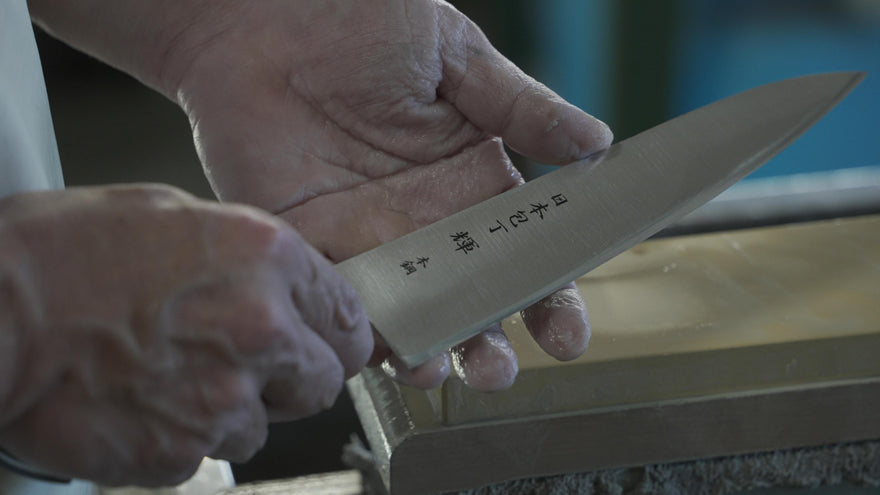We Offer DHL EXPRESS Flat Rate Shipping Worldwide. Just $10 USD for US, Canada, Australia, Asian countries. US$15 for Europe and other Countries in the world
We Offer DHL EXPRESS Flat Rate Shipping Worldwide. Just $10 USD for US, Canada, Australia, Asian countries. US$15 for Europe and other Countries in the world
March 25, 2024

Knife sharpening is a meticulous process requiring precision, patience, and practice. Proper sharpening ensures culinary tools remain in prime condition, enhancing kitchen efficiency, safety, and artistry. This guide covers various sharpening techniques and tools, offering valuable insights for professional chefs and cooking enthusiasts aiming to master this essential skill.
The core of knife sharpening involves selecting and using appropriate whetstones. These stones are not just tools but partners in the sharpening process, each with a unique character and purpose.
Arato (Rough Grit Stone #80 to #400 Grit):Coarse stones are essential for repairing damaged knives. They grind out chips and reshape dull edges. Lower grit numbers remove more material, ideal for initial sharpening stages requiring significant material removal.
Medium Stones: The Backbone of Versatility
Nakato/Medium Grit Stones (#800 to #2000): Medium grit stones are essential for sharpening kitchen knives. For tougher materials, a 1000 grit stone is recommended for a better sharpening experience. Choosing the correct medium grit stone for the knife's material ensures efficient sharpening.
A darker 1000 grit stone is versatile for most knives, except those made from harder steel. For tougher materials, a 1000 grit stone is recommended for a better sharpening experience. Choosing the correct medium grit stone ensures efficient sharpening.
Price: $65.00 US


Price: $65.00 US


Price: $65.00 US


Finishing Stones: The Final Touch
Shiageto / Fine Grit Stones (#3000 to #5000):
Fine grit stones refine and polish the knife edge. After shaping with Arato (Rough Grit Stone) or Nakato (Medium Rough Grit Stone), these stones reduce burr size and polish the blade's surface. The result is a sharper edge with the smoothness and precision needed for delicate cutting tasks.
Hiageto / Super Fine Grit Stones (#6000 to #10,000)
These ultra-fine stones are used for final polishing and refinement of the knife edge. They do not remove material aggressively but polish the edge to a mirror-like finish, enhancing its sharpness and longevity. Knives finished with an 8,000 grit stone exhibit a razor-sharp edge for precise and delicate cuts, essential for high-quality culinary preparation.
Price: $108.00 US


Price: $78.00 US



Price: $86.00 US



Knife sharpening is an art form demanding attention to detail, understanding of geometry, and blade feedback sensitivity.
The sharpening angle is foundational to a knife's sharpness and overall performance, typically ranging from 12 to 15 degrees on each side for most kitchen knives. Consistently maintaining this angle throughout the sharpening process ensures an evenly sharp edge. Techniques to achieve this precision include:
Applying the correct amount of pressure during sharpening is critical to removing the right amount of material from the blade. This aspect of sharpening requires a nuanced touch that is developed through experience:
Starting Strong, Finishing Light: Begin with slightly more pressure when working with coarser stones to shape the edge. Gradually decrease the pressure as you move to finer grit stones. This transition ensures that the finer stones polish and refine the edge rather than removing additional material.
Even Distribution: The pressure should be evenly distributed across the length of the blade to avoid creating uneven spots or indentations. This uniformity is essential for maintaining the blade's structural integrity and ensuring a consistently sharp edge.
The formation of a burr—a fine, feather-like metal lip on the edge opposite the sharpening side—is a clear indicator that the sharpening process is effectively removing material from the blade. Detecting and managing the burr involves:
Sensitivity to Feedback: Feeling for the presence of a burr with your fingers (carefully and safely) or visually inspecting the edge under a light source are ways to gauge the progress of sharpening. This feedback loop is crucial for knowing when to switch sides or move to a finer grit stone.
Delicate Removal: Once a burr is formed, it must be carefully removed to reveal the sharp edge beneath. This is achieved through gentle, alternating strokes on finer grit stones, gradually polishing the edge until the burr is no longer detectable. The removal process requires finesse and technique, balancing careful handling to achieve the perfect edge.
The maintenance of sharpening stones is often overlooked but is a critical aspect of the knife sharpening process. Proper care extends the life of these valuable tools and ensures their readiness and effectiveness for each sharpening session. Here, we delve into the rituals surrounding the preservation of sharpening stones, emphasizing practices beyond basic soaking and wetting.
Understanding the specific needs of your sharpening stones is fundamental to their maintenance:
Medium Grit Stones #400/#1200 and #2000: These stones are porous and absorb water, which acts as a lubricant during the sharpening process. Before use, they should be fully submerged in water until air bubbles cease to emerge. This indicates that the stone has absorbed the necessary moisture. After use, stones should be rinsed clean and allowed to air dry completely before storage to prevent mold growth or cracking.
Fine Grit Stones #1000/#4000, Super Fine Grit #6000, #8000, Combination Whetstone Grit #6000/#10,000: Fine stones often require only a surface application of water to create the necessary lubrication for a smooth sharpening experience. After use, these stones should be gently cleaned with water and a soft brush to remove any metal particles or residue. Allowing them to dry thoroughly before storage maintains their surface integrity and sharpness capabilities.
December 05, 2024
November 11, 2024
For over a decade, the Fu-Rin-Ka-Zan brand has continued to distinguish itself as a top choice among high-end traditional Japanese knives.
October 31, 2024
Sign up to get the latest on sales, new releases and more …
